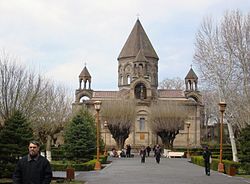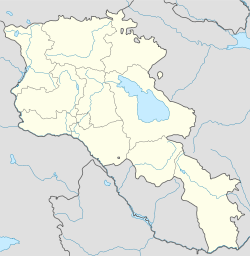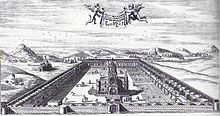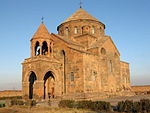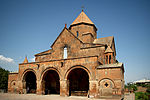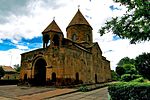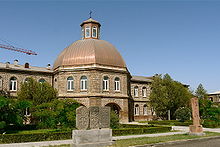- Vagharshapat, Armenia
-
"Etchmiadzin" redirects here. For other uses, see Etchmiadzin (disambiguation).
Coordinates: 40°10′22″N 44°17′33″E / 40.17278°N 44.2925°E
Vagharshapat
ՎաղարշապատEtchmiadzin Cathedral in Vagharshapat 
Flag
SealCoordinates: 40°10′22″N 44°17′33″E / 40.17278°N 44.2925°E Country Armenia Marz (Province) Armavir Established 685 BC Government – Mayor Karen Manvel Grigoryan Area – Total 44.24 km2 (17.1 sq mi) Elevation 853 m (2,799 ft) Population (2009) – Total 57,300 – Density 1,295/km2 (3,354/sq mi) Time zone (UTC+4) – Summer (DST) (UTC+5) Area code(s) 0231 Website official website Sources: Population [1] Vagharshapat (Armenian: Վաղարշապատ), commonly known as Ejmiatsin in Eastern Armenian and Echmiadzin in Western Armenian (Armenian: Էջմիածին), is the fourth-largest city in Armenia and the spiritual centre of the Armenians, as it is the seat of the Catholicos of All Armenians, the head of the Holy Armenian Apostolic Church. It is the most populous city in Armavir province, located about 18 km west of Yerevan, 25 km east of the regional centre of Armavir, only 10 km north of the Armenia-Turkish border. The 1989 census counted the population of Ejmiatsin as 61,000; it has declined considerably since: 58,388 in the 2001 census, and an estimated 56,757 in 2008.
Contents
Geography
Vagharshapat (Ejmiatsin) is the biggest satellite city of Yerevan and the 4th largest in Armenia, close to Zvartnots International Airport. It is located in Eastern Armenia to the center-west of the country in the north-eastern extremity of Ararat Valley, in Kasagh River basin. Historically, Vagharshapat is situated at the heart of the Armenian Highland, in Aragatsotn canton (Armenian: Արագածոտն գաւառ Aragatsotn gavar, not to be confused with the current Aragatsotn Province) of Ayrarat province, within Armenia Major. The city has an average elevation of 853 meters above sea level with a dry continental climate.
History
The territory of ancient Vagharshapat and the surrounding areas has been inhabited since the 3rd millenium BC. Many sites, such as Metsamor, Shresh hill and Mokhrablur, date back to the neolithic period. The first written records about Vagharshapat were found in the inscriptions left by the Araratian king Rusa II (685-645 BC), where it was mentioned as the Valley of Kuarliny. According to Movses Khorenatsi, the oldest name of Vagharshapat was probably Artemid, derived from the ancient Greek deity Artemis. It was renamed Avan Vardgesi (Town of Vardges) or Vardgesavan (Վարդգէսաւան) after being replenished by prince Vardges during the reign of king Orontes I Sakavakyats of Armenia (570-560 BC).
In the first half of the 1st century, during the reign of the Armenian Arshakuni king Vagharsh I (117-144), the old town of Vardgesavan was renovated and renamed Vagharshapat (Վաղարշապատ); this is the official name of the city. The original name, as preserved by Byzantine historian; Procopius (Persian Wars), was Valashabad -"Valash/Balash city" named after king Balash/Valash/Valarsh of Armenia. The name evolved into its later form by the shift in the medial L into a Gh, which is common in Armenian language.
Khorenatsi mentions that the town of Vardges was totally rebuilt and fenced by Vagharsh I to become known as Noarakaghak (The New City) or Vagharshapat.
The city was the capital of the Ashakuni Kingdom of Armenia between 120-330 AD and remained the country's most important city until the end of the 4th century AD. When Christianity became the state religion of Armenia, Vagharshapat gradually came to be known as Ejmiatsin, after the name of the Mother Cathedral. Starting from 301, the city has become the spiritual centre of all the Armenian nation, being the home of the Armenian Catholicosate, one of the oldest religious organisations in the world.
Vagharshapat was home to one of the oldest schools, established by Saint Mashtots, and the first manuscripts library in Armenia, founded in 480 AD. Starting from the 6th century, the city became less important, especially after the transfer of the seat of the Catholicosate to Dvin in 452. With the foundation of the Bagratuni Kingdom of Armenia in 885, it was revived.
After the fall of the Bagratuni dynasty in 1045, the city gradually became an insignificant place until 1441, when the seat of the Armenian Catholicosate was transferred from the Cilician town of Sis back to Etchmiadzin. During the more than 150 years of Turkic rule, the city was called Uchkilisa (Üçkilise, "Three churches" in Turkish language).
The archeological site of ancient Vagharshapat
According to Movses Khorenatsi's History of Armenia and as a result of several archeological researches conducted in the area, the most probable location of the ancient city of Vagharshapat is the area of Shresh Hill near Kasagh River.[2]
Shresh Hill' -or the Kond of Ghugo, as it was called by the local population- is located 500 meters north-east of the current city of Ejmiatsin, on the way to Oshakan. This artificial hill of 123 meters diameter was first excavated in 1870. In 1913 and 1928, the area was excavated by archeologist Yervand Lalayan. Large-scale excavations were conducted in Shresh Hill and the nearby sites of Metsamor and Mokhrablur between 1945-1950.
Landmarks
Etchmiadzin Cathedral
 Etchmiadzin Cathedral, completed in 303
Etchmiadzin Cathedral, completed in 303 Main article: Etchmiadzin Cathedral
Main article: Etchmiadzin CathedralHistorically, the focal point of the city is the Mother Cathedral of Holy Etchmiadzin, (Armenian: Մայր Տաճար Սուրբ Էջմիածին Mayr Tajar Surb Ejmiatsin ) which is one of the oldest churches in the world. Originally known as the Holy Mother of God Church (Armenian: Սուրբ Աստուածածին Եկեղեցի Surb Astvatsatsin Yekeghetsi), it was first built by Saint Gregory the Illuminator as a vaulted basilica in 301-303, when Armenia had just adopted Christianity as a state religion (the first such in world history). The church was enlarged on occasion, notably in 480, 618 and 1658.
Mother See of Holy Etchmiadzin complex
Main article: Mother See of Holy EtchmiadzinThe Mother Cathedral is found in the complex of Mother See of Holy Etchmiadzin (Armenian: Մայր Աթոռ Սուրբ Էջմիածին ), the spiritual and administrative headquarters of the worldwide Armenian Apostolic Church and the Pontifical Residence of the Supreme Patriarch and Catholicos of All Armenians.
The main Etchmiadzin Cathedral is surrounded with many structures built at several times throughout the centuries. Most buildings are of great architectural significance, such as the old and new Pontifical Residences, the Chancellery or the Divanatoon, the Gate of King Trdat, Alex and Marie Manoogian Treasury Museum (1982), Khrimian Museum, Yeremian Monastic cells, the old Seminary building, the Clock Tower, the Bookstore, etc.
Gevorkian Theological Seminary is a theological school-college of the Armenian Apostolic Church founded by Catholicos Gevork IV in 1874 and found in the complex.
Other churches
Apart from the Mother Cathedral, Vagharshapat contains other important Armenian churches and cathedrals. The Cathedral of Etchmiadzin, the Churches of Saint Hripsime, Saint Gayane and Saint Shoghakat, and the Archaeological Site of Zvartnots are listed among the UNESCO World Heritage Sites.
Saint Hripsime Church
Main article: Saint Hripsime ChurchBuilt in 618, Saint Hripsime Church survives basically unchanged. It is considered one of the oldest surviving churches in Armenia, known for its fine architecture of the classical period, which influenced many other Armenian churches. The church was erected in 618 by Catholicos Gomidas atop the original mausoleum, built by Catholicos Sahak the Great in 395, which contained the remains of the martyred Saint Hripsimé.
Saint Gayane Church
Main article: Saint Gayane ChurchBuilt in 630 by Catholicos Ezra I, Saint Gayane Church is distinguished by its harmonious proportions. Its design remained unchanged despite partial renovations of the dome and some ceilings in 1652.
Saint Shoghakat Church
Main article: Shoghakat ChurchMeaning "the drop of light"), Shoghagat Church is a domed single-nave basilica, completed in 1694 by prince Aghamal Sorotetsi during the time of Catholicos Nahabed I. Built with red and black tufa stones, the church was erected on the remains of a 6th-century basilica. Adjacent to Shoghakat, the remains of a 5th-century small chapel could be found.[3]
Zvartnots Cathedral
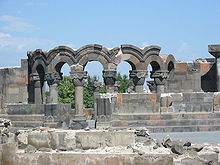 The ruins of Zvartnots Cathedral, 641
The ruins of Zvartnots Cathedral, 641 Main article: Zvartnots Cathedral
Main article: Zvartnots CathedralZvartnots is a ruined 7th century circular Armenian cathedral built by the order of Catholicos Nerses III the Builder in 641-653, located at the eastern edge of current Vagharshapat.
Zvartnots was a majestic cathedral famous for its unique design, dedicated to Saint George, built at the place where a meeting between king Tiridates III and Saint Gregory the Illuminator was supposed to have taken place.
In 930 AD, the church was ruined by an earthquake, and remained buried until its rediscovery in the early 20th century. The site was excavated between 1900 and 1907, uncovering the foundations of the cathedral as well as the remains of the Pontifical palace and a winery.
Education and sports
Gevorkian Theological Seminary is one of the most famous educational institutions of the Republic of Armenia. Other educational institutions include Grigor Lusavorich University and the state intermediate college of vocational education. There are 14 public education schools, 8 kindergartens and 2 musical schools operating in the city.[4]
Vagharshapat Echmiadzin was the city's only football club; it made its debut in the Armenian Premier League as Zvartnots Echmiadzin in 1992. The club was dissolved in early 2006 and is currently inactive from professional football.
The "Ejmiatsin Day" is celebrated on 8 October of every year since 2008. According to tradition, Mesrop Mashtots brought the newly created Armenian alphabet to Vagharshapat on 8 October 405.[5]
International relations
Vagharshapat (Etchmiadzin) is a member of the Organization of World Heritage Cities (OWHC)[6] since 2007.[7]
Sister cities
Currently, Vagharshapat-Ejmiatsin has 6 sister cities:[8]
City Region Country Year Issy-les-Moulineaux  Île-de-France
Île-de-France France
France1989 Petrozavodsk  Karelia
Karelia Russia
Russia2004 Fresno  California
California United States
United States2009 Sergiyev Posad  Moscow Oblast
Moscow Oblast Russia
Russia2010 Hadrut  Nagorno-Karabakh
Nagorno-Karabakh Azerbaijan
Azerbaijan2010 Martakert  Nagorno-Karabakh
Nagorno-Karabakh Azerbaijan
Azerbaijan2010 See also
- Armenian Apostolic Church
- Vagharshapat F.C. - Echmiadzin football club
- Echmiadzin Gospels
References
External links
- Armenia Photos: The Holy City of Etchmiadzin - by East-Site.com
- Etchmiadzin Old Photos - by ChurchInArmenia.com
Historic capitals of Armenia Tushpa 825-c 500+BC • Ani • Armavir c 400 BC & 331-160 BC • Yervandashat 4th century BC • Artashat 160-77 BC, 60 BC-120 AD • Antioch 160-77 BC, 60 BC-120 AD • Tigranakert 77-69 BC • Vagharshapat 120-330 • Sis • Dvin 336-428 • Bagaran 428-933 • Shirakavan • Kars • Yerevan
World Heritage Sites in Armenia Monasteries of Haghpat and Sanahin · Monastery of Geghard and the Upper Azat Valley · Cathedral and Churches of Echmiatsin (Saint Hripsime, Saint Gayane, Shoghakat) and the Archaeological Site of Zvartnots
Sites on the Tentative List:
The archaeological site of the city of Dvin · The basilica and archaeological site of Yererouk · The monastery of Noravank and the upper Amaghou Valley · The monasteries of Tatev and Tatevi Anapat and the adjacent areas of the Vorotan Valley Categories:
Categories:- Populated places in Armavir
- Holy cities
- Former capitals of Armenia
Wikimedia Foundation. 2010.

